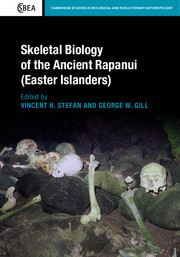Book contents
- Frontmatter
- Contents
- List of contributors
- Acknowledgements
- 1 Introduction: Research overview
- 2 Review of Polynesian and Pacific skeletal biology
- 3 Chronology and Easter Island prehistory
- 4 A descriptive skeletal biology analysis of the ancient Easter Island population
- 5 Craniometric variation of the prehistoric Polynesians and Rapanui
- 6 Rapanui non-metric cranial traits
- 7 Intra-island discrete cranial trait variation
- 8 Continuous non-metric characteristics of the early Rapanui
- 9 Rapanui dental morphology
- 10 Pelvic variability and sexual dimorphism in prehistoric Rapanui
- 11 Genetic affinities of the Rapanui
- 12 Archaeogenetics and paleodemographic estimation of founding populations: Features of residential geography on Rapa Nui
- 13 Evidence for injuries and violent death
- 14 Demographic analysis of modified crania from Rapa Nui
- 15 East Polynesian and Paleoindian parallels and contrasts in skeletal morphology
- 16 Rapanui origins, relationships, and warfare: A summary in theoretical context
- References
- Index
16 - Rapanui origins, relationships, and warfare: A summary in theoretical context
Published online by Cambridge University Press: 05 December 2015
- Frontmatter
- Contents
- List of contributors
- Acknowledgements
- 1 Introduction: Research overview
- 2 Review of Polynesian and Pacific skeletal biology
- 3 Chronology and Easter Island prehistory
- 4 A descriptive skeletal biology analysis of the ancient Easter Island population
- 5 Craniometric variation of the prehistoric Polynesians and Rapanui
- 6 Rapanui non-metric cranial traits
- 7 Intra-island discrete cranial trait variation
- 8 Continuous non-metric characteristics of the early Rapanui
- 9 Rapanui dental morphology
- 10 Pelvic variability and sexual dimorphism in prehistoric Rapanui
- 11 Genetic affinities of the Rapanui
- 12 Archaeogenetics and paleodemographic estimation of founding populations: Features of residential geography on Rapa Nui
- 13 Evidence for injuries and violent death
- 14 Demographic analysis of modified crania from Rapa Nui
- 15 East Polynesian and Paleoindian parallels and contrasts in skeletal morphology
- 16 Rapanui origins, relationships, and warfare: A summary in theoretical context
- References
- Index
Summary
Mystery surrounds Easter Island at a number of levels, and this has made the tiny island and its interesting people, with their surprisingly advanced prehistoric culture, a focal point of interest for the outside world. Especially Western scholars have made great efforts to explore the island since its discovery by Europeans in 1722, with an attempt to answer the many questions raised by its isolated existence in the midst of a vast ocean. Who are these far away people who look similar to Europeans? Where did they come from? How did they get to this tiny island? How could they produce monumental architecture within such a small, remote location? What happened to bring an end to their advanced society? As pointed out in the early chapters of this volume, these “big questions” have riveted the attention of scientists and others for a very long time, as have other questions at a level of greater specificity, such as: How exactly were the statues carved? How were they moved and erected? What exact forces precipitated the social decline?
The contributions within this volume by mostly biological anthropologists and geneticists have helped answer some of these questions (e.g., origins and relationships), contributed important information towards answering others (e.g., settlement theories, injuries and conflict, social decline), and have lent little or nothing to others (e.g., carving and moving of statues). We biologists have little to offer regarding statue production and transport, and will leave the resolution of those mysteries to the engineers and archaeologists!
The major findings presented within the chapters of this volume are briefly summarized here under three primary subject headings: 1. basic skeletal structure and the physical appearance of the ancient Rapanui, 2. genetic composition and relationships, and 3. conflict and injury. Some of our findings also bear upon settlement theory (i.e., potential routes to Easter Island) and will be discussed in a fourth and final section on origins and settlement.
As outlined earlier in the Introduction (Chapter 1), the inspiration for much of the research work presented here grew out of the 1981 Easter Island Anthropological Expedition.
- Type
- Chapter
- Information
- Skeletal Biology of the Ancient Rapanui (Easter Islanders) , pp. 286 - 302Publisher: Cambridge University PressPrint publication year: 2016
- 3
- Cited by



